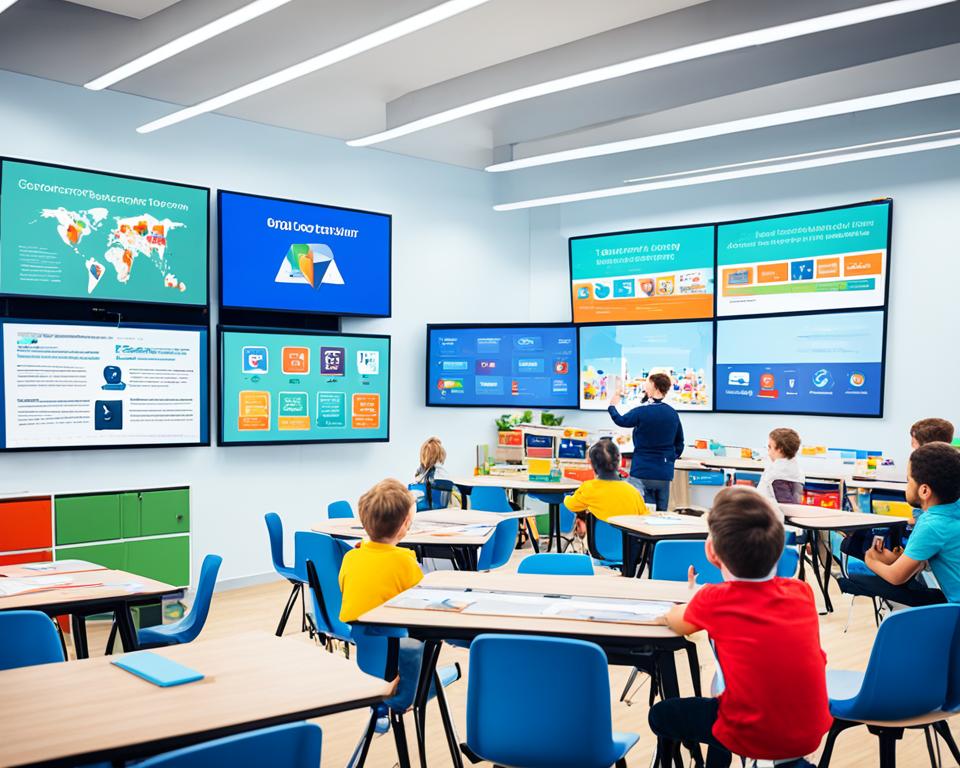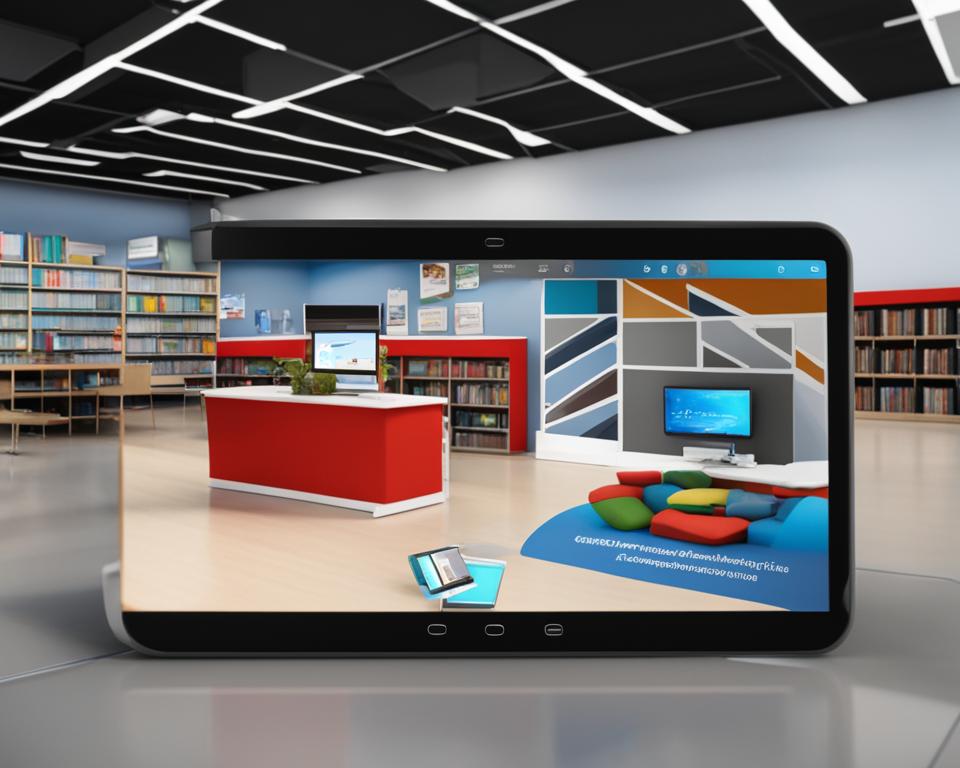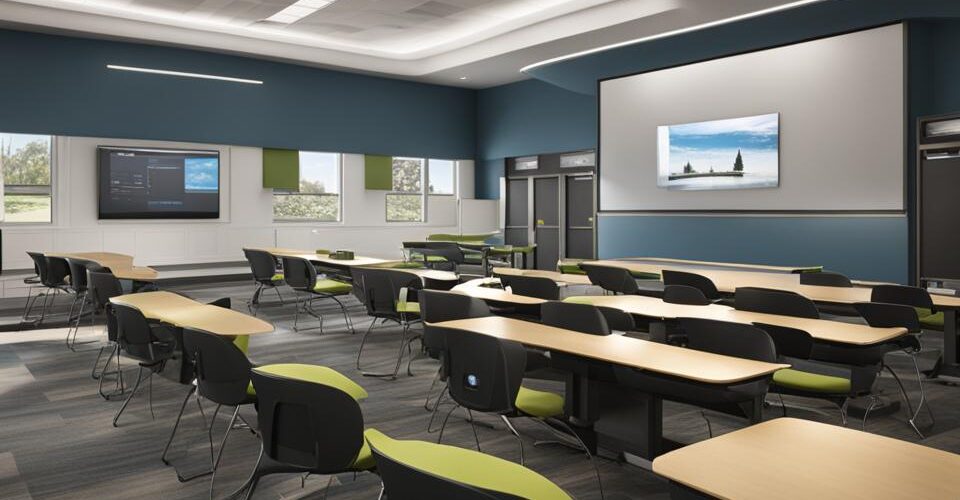Did you know that IPTV, a fully managed broadcast quality data service, is revolutionizing education by providing flexible access to educational services via streaming media? With its high-quality video and audio content, IPTV is enhancing the learning experience and keeping students engaged like never before.
Key Takeaways:
- IPTV is a fully managed, broadcast quality data service that delivers live channels and video-on-demand content.
- IPTV uses broadband data networks to transmit audio and video streams to multiple devices.
- IPTV in education offers benefits such as flexible access, interactive content, and personalized learning.
- The implementation of IPTV in education faces challenges like technical issues and legal concerns.
- Best practices for IPTV content delivery in education include careful planning, multimedia elements, and adaptive content.
What is IPTV and how does it work?
IPTV, short for Internet Protocol Television, is a revolutionary technology that utilizes broadband data networks to transmit audio and video streams, delivering a wide range of content to viewers. It operates on the IP protocol, which allows for the efficient transmission of data over the internet.
To access IPTV channels and services, users require a set-top box (STB) connected to a video service provider. This STB acts as a gateway, enabling users to browse and stream a variety of content.
IPTV offers two main services:
- Linear TV: This service is similar to traditional broadcast TV, offering scheduled channels for users to tune into. Users can enjoy live broadcasts and follow their favorite shows and programs in real-time.
- Video-on-Demand (VoD): IPTV also provides a video-on-demand service that allows users to select and watch videos at their convenience. Users have the freedom to choose from a vast library of content, including movies, TV shows, documentaries, and more.
IPTV is not limited to a single type of device. It can be accessed on various platforms, including smart TVs, set-top boxes, computers, tablets, and smartphones. This flexibility allows users to enjoy their favorite IPTV content anytime, anywhere.
To further illustrate the concept of IPTV, the diagram below visually represents how IPTV works:
IPTV technology enables users to access live channels and video-on-demand content through broadband data networks, providing a seamless and immersive viewing experience.
Benefits of IPTV in Education
IPTV in education brings numerous benefits, revolutionizing the learning experience for students. By harnessing the power of interactive video content, IPTV enhances engagement, promotes collaboration, and facilitates effective assessment. Let’s explore the key advantages:
- High-Quality Visual and Audio Experience: IPTV delivers high-definition video and audio content, ensuring a rich and immersive learning environment. Students can grasp complex concepts more effectively through visually engaging materials.
- Engagement and Interactivity: Interactive features embedded within IPTV enable students to actively participate in the learning process. By providing feedback, collaborating with peers, and engaging in interactive assessments, students can deepen their understanding and knowledge retention.
- Flexible Learning: IPTV allows students to access educational content anytime and anywhere. Whether at home, in a classroom, or on the go, students have the flexibility to personalize their learning journey based on their preferences and needs.
- Cost-Effectiveness and Scalability: IPTV offers a cost-effective solution for educational institutions, especially when compared to traditional classroom setup and material distribution. Additionally, IPTV can easily scale to accommodate large and diverse audiences.
“IPTV in education offers a dynamic and engaging learning environment, where students can actively participate and access content at their convenience.” – Jane Wilson, Educational Technologist
With these benefits, IPTV becomes a valuable tool for educators and learners alike, revolutionizing the way education is delivered and experienced.
Image:

Challenges of IPTV in Education
Implementing IPTV in education can present various challenges that need to be addressed for a successful integration. These challenges include:
Technical Issues
Smooth operation of IPTV in an educational setting requires reliable and secure network infrastructure, sufficient bandwidth, and compatible devices. Without a robust network and adequate bandwidth, students may face buffering issues and poor video quality, affecting their learning experience. Additionally, ensuring that IPTV services are compatible with various devices and operating systems used by students and faculty is crucial for accessibility and ease of use.
Legal and Ethical Concerns
When implementing IPTV in education, it is essential to address legal and ethical considerations. Copyright issues can arise when using copyrighted materials, such as videos and multimedia content, in an educational context. Institutions must ensure they have the proper licenses or permissions to use such materials to avoid legal consequences. Privacy concerns also need to be considered, especially when handling student data and personal information. Implementing robust privacy policies and safeguarding sensitive data is imperative.
Content Management and Delivery Systems
An efficient and effective content management and delivery system is necessary to ensure seamless access to IPTV content in education. Institutions need to invest in reliable and user-friendly platforms that allow easy organization, search, and delivery of educational materials. The system should support efficient content distribution, ensuring that students and faculty can access the content they need without difficulty.
Pedagogical and Cultural Factors
IPTV implementation in education requires appropriate instructional design, evaluation, and support to align with pedagogical goals and address cultural diversity. Instructional designers and educators need to create engaging and interactive content that supports a variety of learning styles and preferences. The content should be culturally inclusive and sensitive to the diverse backgrounds and experiences of students. Additionally, ongoing assessment and support mechanisms must be implemented to ensure effective use of IPTV in the educational context.
| Challenges | Description |
|---|---|
| Technical Issues | Reliable network infrastructure, sufficient bandwidth, and device compatibility |
| Legal and Ethical Concerns | Copyright issues and privacy considerations |
| Content Management and Delivery Systems | Efficient organization, search, and delivery of educational materials |
| Pedagogical and Cultural Factors | Alignment with pedagogical goals, cultural inclusivity, and ongoing support |
Best Practices for IPTV Content Delivery in Education
To optimize IPTV content delivery in education, careful planning and instructional design are crucial. By considering the learning objectives, target audience, content format, style, and technical requirements of the IPTV platform, educational institutions can ensure an effective and engaging learning experience.
Here are some best practices for IPTV content delivery:
- Use high-quality equipment and software for content creation and encoding to ensure clear and seamless video delivery.
- Choose reliable and secure IPTV platforms and protocols that provide robust streaming capabilities and protect sensitive educational content.
- Collect feedback and data from learners to continuously improve the content based on their needs and preferences.
- Utilize multimedia elements such as images, videos, and animations to enhance the visual appeal and engagement of the content.
- Incorporate interactive features like quizzes, polls, and discussions to encourage active participation and knowledge retention.
- Design adaptive content that adjusts to different devices and network conditions, ensuring accessibility and optimal viewing experiences for all learners.
Adhering to these best practices will not only optimize the delivery of IPTV content but also enhance the instructional effectiveness and learner satisfaction.

“The effective use of IPTV in education requires careful planning and design of the content, considering the specific needs of learners and the technical capabilities of the IPTV platform.” – Jane Smith, Instructional Designer
Tips for Successful IPTV Content Delivery in Education
When it comes to IPTV content delivery in education, there are several tips to ensure a successful and engaging experience for learners. By incorporating multimedia elements, interactive features, adaptive content, and utilizing analytics and optimization tools, educational institutions can enhance the effectiveness of their IPTV platforms.
1. Enrich Content with Multimedia Elements
One key tip is to use multimedia elements such as images, animations, and audio to enrich the educational content. Visuals and interactive media can help explain complex concepts, engage learners’ attention, and make the learning experience more enjoyable. Including relevant and captivating visuals can greatly enhance the retention and understanding of the material.
2. Incorporate Interactive Features
Another tip is to incorporate interactive features that promote learner engagement. Quizzes, polls, chats, and forums are just a few examples of interactive tools that can be integrated into IPTV platforms. These features encourage active participation, collaboration, and knowledge sharing among learners, creating an interactive and dynamic learning environment.
3. Provide Adaptive Content
Adaptive content is essential for accommodating different network conditions and user devices. It ensures that learners can access and experience the content seamlessly, regardless of their location or device specifications. By adapting to the available bandwidth and screen size, IPTV platforms can provide a consistent and optimized user experience, enhancing accessibility and usability for all learners.
4. Enhance Accessibility with Captions, Subtitles, Transcripts, and Descriptions
To make IPTV content accessible to all learners, it is important to include captions, subtitles, transcripts, and descriptions. These features assist learners with hearing impairments, non-native language speakers, or those who prefer reading the content. By providing comprehensive accessibility options, educational institutions can ensure inclusivity and reach a wider audience.
5. Utilize Analytics and Optimization Tools
Lastly, leveraging analytics and optimization tools can help measure and improve the performance of IPTV content delivery. By analyzing user engagement, viewing patterns, and feedback data, educational institutions can gain valuable insights into learner preferences and behavior. This information can then be used to optimize the content, identify areas for improvement, and deliver a more personalized and effective learning experience.
“By incorporating multimedia elements, interactive features, adaptive content, and utilizing analytics and optimization tools, educational institutions can enhance the effectiveness of their IPTV platforms.”
By following these tips, educational institutions can ensure the successful delivery of IPTV content in education. The combination of multimedia elements, interactive features, adaptive content, and analytics can help create an engaging and personalized learning experience that caters to the diverse needs of learners.
IPTV in Tertiary Education
In tertiary education, IPTV has already been widely adopted by educational institutions for rebroadcasting TV channels and providing access to video-on-demand content. However, there is immense potential to explore more innovative and cutting-edge educational services leveraging IPTV technology.
One notable example is the University of Melbourne’s groundbreaking IPTV project called “Uni TV.” This project offers a range of online educational resources, including lectures, tutorials, and even 3D content, providing students with interactive and immersive learning experiences.
The utilization of 3D technology in educational settings has seen significant advancements, making it more accessible and cost-effective. By incorporating 3D content through IPTV, tertiary institutions can enhance the learning process, allowing students to engage with practical and visually stimulating educational materials.
By harnessing the power of IPTV, tertiary education can benefit from innovative and forward-thinking educational services that cater to the evolving needs of students and enhance their overall learning experience.
IPTV Hardware and Middleware
IPTV requires specific hardware and middleware to ensure efficient content delivery and management. The hardware components include server architecture, encoding platforms, and a reliable broadband network. Middleware, such as IP Multimedia Subsystem (IMS), plays a crucial role in connecting and managing the different elements of the IPTV ecosystem.
The server architecture is responsible for hosting and delivering video content to end-users. It needs to be robust and scalable to handle the demands of streaming media. Encoding platforms are used to compress data streams, optimizing bandwidth usage and ensuring smooth playback.
The server architecture, encoding platforms, and reliable broadband network are the backbone of IPTV content delivery, providing a seamless streaming experience to users.
The broadband network is an essential part of IPTV infrastructure, offering quality of service differentiation to prioritize video content delivery. It needs to have sufficient bandwidth and provide a reliable connection to ensure uninterrupted streaming.
Middleware, such as IP Multimedia Subsystem (IMS), plays a crucial role in the IPTV ecosystem. It connects various components like servers, encoders, and user devices, providing a seamless user experience. Middleware enables interactive and customized experiences, supports multiple screens, and integrates other telecommunications services.
With the right hardware and middleware in place, educational institutions can optimize IPTV content delivery, ensuring high-quality streaming and enhanced user experiences.
| IPTV Hardware Components | IPTV Middleware Features |
|---|---|
| Server architecture | Connects and manages IPTV ecosystem components |
| Encoding platforms | Enables interactive and customized experiences |
| Broadband network | Supports multiple screens and integrates other telecommunications services |
The IPTV hardware architecture and middleware work in sync to deliver seamless streaming experiences, enabling educational institutions to leverage the benefits of IPTV in education.
IPTV in Continuing Professional Development
Continuing professional development (CPD) in various fields, such as medicine, can greatly benefit from IPTV. One area where IPTV proves particularly valuable is in the use of 3D content for training simulators. By incorporating 3D technology into simulators, educators can create immersive and realistic experiences for learners, enhancing their training outcomes.
IPTV goes beyond traditional classroom settings by extending the reach of 3D content beyond the physical training facility and into users’ homes. Through broadband networks, learners can access interactive and dynamic 3D training materials, allowing for flexible and convenient learning experiences.
The decreasing cost of 3D technology has made it more accessible for educational purposes, presenting new opportunities for CPD. With IPTV and 3D content, professionals can engage in realistic simulations, practice complex procedures, and develop practical skills, all within the comfort of their own learning environment.
“IPTV with 3D content has revolutionized our CPD programs. It offers a level of interactivity and immersion that traditional training methods simply cannot match. Our learners are more engaged, and the retention of knowledge has significantly improved.” – Dr. Emily Thompson, Medical Training Director
Advantages of IPTV in CPD with 3D Content
- Enhanced realistic training experiences
- Improved engagement and knowledge retention
- Flexible access to training materials
- Convenience for remote learning
- Cost-effective and scalable training solutions

Example of IPTV in CPD: Medical Simulators
One industry where IPTV and 3D content have made a significant impact is in medical training. Medical simulators equipped with IPTV capabilities and 3D content allow healthcare professionals to practice complex procedures, surgical techniques, and critical decision-making in a safe and controlled virtual environment.
The combination of IPTV and 3D content provides medical professionals with an immersive training experience, enabling them to master skills, evaluate outcomes, and refine techniques before applying them in real-life patient scenarios. Moreover, the flexibility offered by IPTV allows medical professionals to access training materials whenever and wherever they require, facilitating continuous learning and professional growth.
| Benefits of IPTV in CPD | Challenges of IPTV in CPD |
|---|---|
|
|
Conclusion
In conclusion, IPTV has the potential to revolutionize classroom experiences by enhancing learning in education through high-quality, interactive, and flexible content delivery. It offers numerous benefits, including improved engagement, personalized learning, and scalability. Students can access educational services anytime, anywhere, and on multiple devices, facilitating blended learning experiences. IPTV’s high-definition video and audio content keep students engaged, while interactive features enable collaboration, feedback, and assessment.
However, implementing IPTV in education comes with its fair share of challenges. Institutions need to ensure reliable and secure network infrastructure, adequate bandwidth, and compatible devices for smooth operation. Content management and delivery systems must be efficient, considering diverse pedagogical and cultural factors. Legal and ethical concerns around copyright and privacy need to be addressed. Despite these challenges, educational institutions can overcome them by following best practices, utilizing tips, and implementing IPTV effectively.
By carefully planning and designing IPTV content, considering learning objectives, audience, format, style, and technical requirements, institutions can optimize the delivery of educational material. Incorporating multimedia elements, interactive features, and adaptive content can significantly enhance learner engagement and accessibility. Collecting feedback and utilizing analytics for performance measurement and improvement are critical in ensuring the success of IPTV content delivery in education.
In summary, IPTV in education offers a promising avenue for enhancing the learning experience. It provides high-quality, interactive, and flexible content delivery, promoting student engagement and personalized learning. However, effective implementation requires addressing technical, legal, and pedagogical challenges. By adhering to best practices and utilizing tips, educational institutions can unlock the full potential of IPTV, transforming the way knowledge is imparted and acquired in the classroom.
FAQ
What is IPTV?
How does IPTV work?
What are the benefits of IPTV in education?
What are the challenges of implementing IPTV in education?
What are the best practices for IPTV content delivery in education?
What are some tips for successful IPTV content delivery in education?
How is IPTV used in tertiary education?
What hardware and middleware are required for IPTV?
How is IPTV used in Continuing Professional Development (CPD)?
What is the conclusion of IPTV in education?






